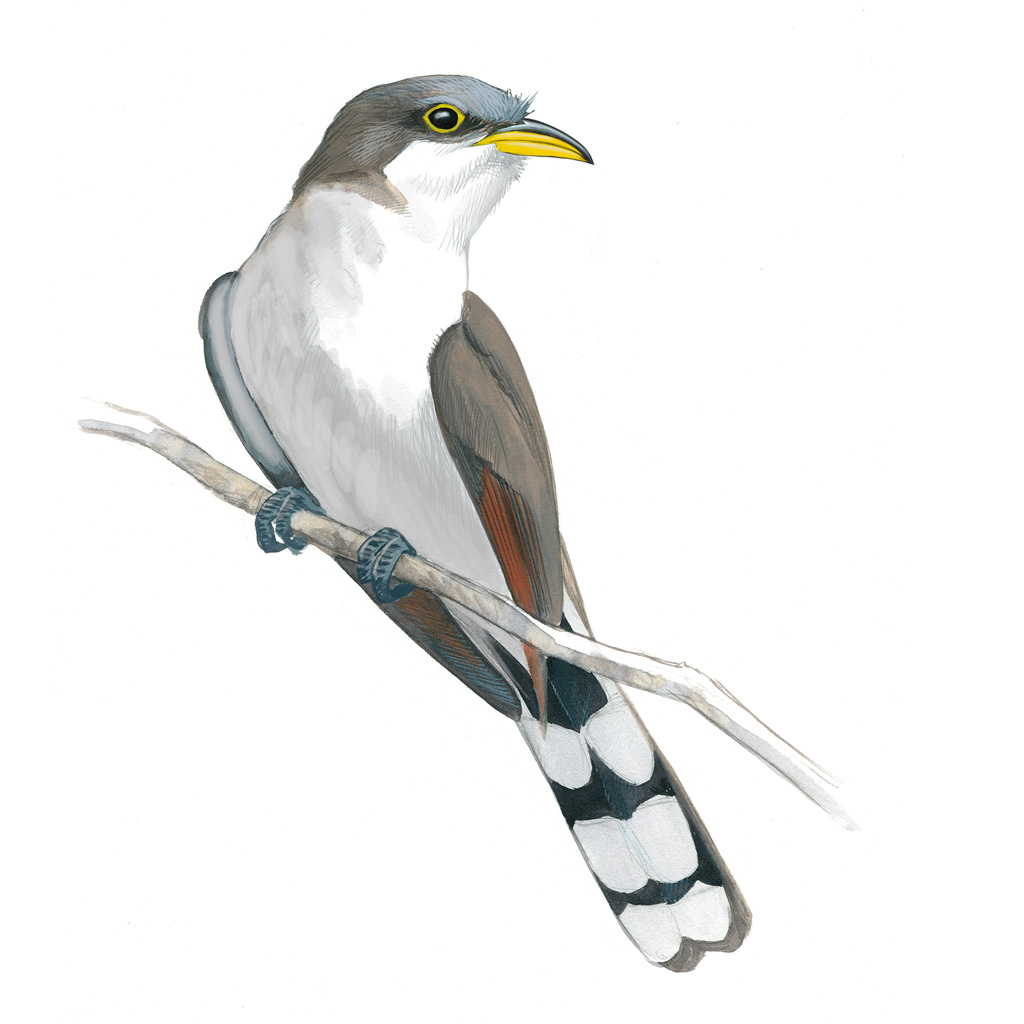AUTHOR: Antonio de Luca, Dave Taft and Umi Syam
There is an obvious upside to the unnatural pall that has fallen over the city. Suddenly, in place of car horns, roaring planes, rattling trains and buses, New York City seems to be filled with bird song.
The birds are not new to the city. It’s just that the pause in the urban soundtrack happens to coincide with the peak of the spring migration along the Atlantic coast. The birds have always been here. This spring, we can hear them.
Here is a mix of the birds passing through New York right now. Some are easy to spot, and some offer more of a challenge; some are best found only in the mornings or at dusk. And some will probably only be heard, and never seen.
LISTEN FOR
A sharp, staccato, “Kak-kak-kak-kak!” It’s the mysterious bird hiding the jungle in every Tarzan movie.
WHERE TO FIND ONE
Early mornings at the edges of woodlands. Stake out tent caterpillar nests; cuckoos have a weakness for them.
In flight, the yellow-billed cuckoo has attractive rust-colored wing patches, with white spots arranged in parallel lines along the underside of a long tail.
Long and lean, these birds perch in the dense tangles of local woodlands. Their ability to hide is legendary, but hearing them always confirms their presence, and that is always easier without airplanes overhead.
LISTEN FOR
Riotous laughing, braying.
WHERE TO FIND ONE
Small and shapely, with a dark red bill and legs and a black head, the laughing gull can be spotted all day along shorelines or in the Rockaways and parts of southern Brooklyn.
Around New York City, laughing gulls have staked out a claim to the marshes of Jamaica Bay in Brooklyn and Queens, and have forced a grudging relationship with the Federal Aviation Administration at Kennedy Airport.
LISTEN FOR
A melodic trill that sounds like a robin with a sore throat.
WHERE TO FIND ONE
Thoreau put it best: “The tanager flies through the green foliage as if it would ignite the leaves.”
Scarlet tanagers prefer the crowns of trees. Despite plumage so bright they look lit from within, they stay out of sight.
Only the males show this brilliant scarlet, and only in spring. By late summer, they begin to shed their flaming red to resume a more sensible, camouflaged life in olive green. Females remain drab green all year, a better strategy for protecting valuable eggs while nesting.
During the height of the spring migration — that is, now — wander woodlands in the mornings.
LISTEN FOR
A high-pitched “killy, killy, killy” or a loud chirp that carries very effectively over open water.
WHERE TO FIND ONE
There is no mistaking this graceful hawk. It has a white-crested head with dark, horizontal eye stripes. In flight, ospreys’ long wings are bent, with a dark patch at each wrist. Ospreys are found anywhere there is open water, from the Central Park Reservoir to the edges of Queens.
LISTEN FOR
A buzzy, husky call described as “Zoo-zoo-zee-zoo!”
WHERE TO FIND ONE
These warblers challenge even binocular-wielding birders because of their preference for heights. Fortunately, the male’s distinct black markings and yellow-green face and upper body make identification pretty easy.
Males are particularly active and never seem to stop calling and flitting about the branches. Where taller trees are absent, birds may forage at lower levels.
LISTEN FOR
A repeated and piercing “Will, will, willet, will, will, willet.” Which is why they’re called willets.
WHERE TO FIND ONE
Choose a shoreline, and you’ll hear these charismatic birds before you see them. Pelham Bay in the Bronx and Plumb Beach in Brooklyn are two places to look. During breeding, males make themselves very visible on fence posts and open snags on quiet bay beaches.
LISTEN FOR
One of the most magnificent screams in the bird kingdom.
WHERE TO FIND ONE
Red-tailed hawks seem to be all over the city, from Central Park to parkway median strips, always glaring, on the lookout for rodents.
In flight this bird spreads its broad wings and tail, often soaring on thermals. And as for that iconic cry: As impressive as bald eagles look, their high-pitched chirps can be underwhelming. When an eagle cries in a car commercial or a cowboy movie, you’re probably hearing the dubbed scream of a red-tailed hawk.
LISTEN FOR
A unique “peenting” of the adult males.
WHERE TO FIND ONE
A landlocked shorebird with a plump body and a long, probing bill, the woodcock is unmistakable but difficult to see in dim light. Just the same, it’s worth trying to spy on one of spring’s most captivating rituals. Listen for the unusual peenting call in a field in the late evening or at dawn in spring. Stay silent and still. Breeding woodcocks will emerge and suddenly spiral upward in a mating flight that takes them 50 or 60 feet high, before falling back to their original locations.
Unfortunately, these birds seem prone to window strikes during migration, and can sometimes be observed, up close, recovering, or deceased below large buildings in early spring.
LISTEN FOR
The famous (among birders) “Cock-a-r-e-e-e.” It is the sound of spring.
WHERE TO FIND ONE
Females are a streaky brown color in order to camouflage with vegetation while raising their young. But around the edges of wetlands, ponds or saltwater bays, males make themselves very visible: They are jet black in breeding season, with brilliant orange and yellow shoulders. They are unmistakable.
LISTEN FOR
A clear, musical three-note call, but the final syllable is an anatomical wonder: several tones produced simultaneously, resulting in a complex, oddly metallic and resonant call, like a softly echoing tambourine.
WHERE TO FIND ONE
Rusty brown overall, the wood thrush spends most of its time foraging through leaf litter looking for insects and other prey. Its breast is a warm white with well-defined speckling, and it has a prominent eye-ring. But you are more likely to hear this bird before you see it.
The call of the wood thrush is the sound of summer evenings.
LISTEN FOR
A repetitive, piercing “witchety-witchety-witchety-witchety” from low tangles of vegetation.
WHERE TO FIND ONE
The yellowthroat prefers swampy tangled shrubbery, where it can be observed low in the branches foraging for insects.
One of the most attractive warbler species, it is easy enough to spot without binoculars. The males have a broad bandit’s mask (very pronounced during breeding season) set off by a white band. Both males and females are a warm olive green, shading toward yellow at the face and breast, the females a little less bright.
LISTEN FOR
There are many comical mnemonics for this bird’s unique and plaintive call. Most common are probably “O sweet Canada Canada!” or the oddly specific “Sam Peabody…Peabody…Peabody.”
WHERE TO FIND ONE
The cutest, most lovable little sparrow out there. At this time of year, males are marked with bright yellow spots just above their bill (the “lores,” technically), a bright white throat and stripes across their heads, set off by crisp black markings. You’ll find them at the edges of woodlands, at bird feeders or even streetside near parks.
As days lengthen, males begin their plaintive calling, and freshen up their plumage, so that a bird who is with us most of the year suddenly appears like a recent arrival from warmer ports of call. Two forms of this bird coexist, tan-crowned and white-crowned — each attracted to the opposite color for breeding purposes.
LISTEN FOR
A mournful cooing, often mistaken by the novice for the hoot of an owl.
WHERE TO FIND ONE
The mourning dove looks like an especially graceful pigeon, with a long, pointed tail and a small head. Though they can be seen year-round, they begin their distinctive calling in spring, especially in parks, yards and wherever food is available.
Source: https://www.nytimes.com/interactive/2020/05/31/nyregion/coronavirus-birding-nyc.html

















